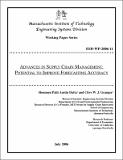Potential to Improve Forecasting Accuracy: Advances in Supply Chain Management
| dc.contributor.author | Datta, Shoumen | |
| dc.contributor.author | Granger, Clive | |
| dc.date.accessioned | 2008-07-31T11:57:42Z | |
| dc.date.available | 2008-07-31T11:57:42Z | |
| dc.date.issued | 2008-07-31T11:57:42Z | |
| dc.identifier.uri | http://hdl.handle.net/1721.1/41905 | |
| dc.description | Forecasting is a necessity almost in any operation. However, the tools of forecasting (software) in general business use are still primitive in view of the strides made by research. Hence, promoting advances in forecasting to aid predictive analytics is deemed a worthwhile endeavour and is the purpose of this paper. Such tools may further reduce uncertainty and volatility characteristic of global trade. The relationship of various business parameters that may change and impact decisions are so abundant that any credible attempt to drive meaningful associations are in demand by global businesses. This paper proposes some modifications to adapt an already advanced forecasting technique (GARCH) with the aim to develop it as a decision support tool applicable to a wide variety of distributed decision systems including supply chain management. | en |
| dc.description.abstract | Forecasting is a necessity almost in any operation. However, the tools of forecasting are still primitive in view of the great strides made by research and the increasing abundance of data made possible by automatic identification technologies, such as, radio frequency identification (RFID). The relationship of various parameters that may change and impact decisions are so abundant that any credible attempt to drive meaningful associations are in demand to deliver the value from acquired data. This paper proposes some modifications to adapt an advanced forecasting technique (GARCH) with the aim to develop it as a decision support tool applicable to a wide variety of operations including supply chain management. We have made an attempt to coalesce a few different ideas toward a “solutions” approach aimed to model volatility and in the process, perhaps, better manage risk. It is possible that industry, governments, corporations, businesses, security organizations, consulting firms and academics with deep knowledge in one or more fields, may spend the next few decades striving to synthesize one or more models of effective modus operandi to combine these ideas with other emerging concepts, tools, technologies and standards to collectively better understand, analyze and respond to uncertainty. However, the inclination to reject deep rooted ideas based on inconclusive results from pilot projects is a detrimental trend and begs to ask the question whether one can aspire to build an elephant using mouse as a model. | en |
| dc.description.sponsorship | MIT Forum for Supply Chain Innovation http://supplychain.mit.edu/shoumen | en |
| dc.language.iso | en | en |
| dc.subject | Forecasting, Analytics, Automatic Identification, Radio Frequency Identification, RFID, Ultrawideband, UWB, sensors, Value of Data, Decision Systems, Decision Support Systems, DSS, Supply Chain, Supply Chain Management, SCM, Operations, Operations Management, Inventory Management, Out-of-Stock, OOS, Process Knowledge, Knowledge Management, Collaboration, Semantics, Interoperability, Collaborative Planning Forecasting and Replenishment, CPFR, Vendor Managed Inventory, VMI, Operational Efficiency, Econometrics, Time Series, CLRM, Regression Analysis, Classical Linear Regression Model, AR, Autoregression, MA, Moving Average, VAR, Vector Autoregression, GARCH, Generalized Autoregressive Conditional Heteroskedasticity, MGARCH, Multivariate GARCH, Bullwhip Effect, Homoskedasticity, Uncertainty, Optimization, Risk Analysis, Value at Risk, VaR, Enterprise Resource Planning, ERP, Software Defined Radio, SDR, Globalisation, Volatility, ICT, Information and Communication Technologies, Supply Chain Adaptability, Adaptive SCM, Sense & Respond, Clockspeed, Value Networks, Product Lifecycle Management, PLM, Information Lifecycle Management, ILM, Obsolescence, Financial Supply Chain, Transparency, Lean, Lean Manufacturing, Outsourcing, GE VeriWise, GPS, High Volume Data, High Frequency Data, Real-Time Data, Right Time Information, Logistics, Security, Security Risk Analysis, Logistics Network, Customs, Customs Security, Biometrics, Ontology, Intelligent Decision Systems, Agents, AI Agents, Logistics Network, Value Chain, C-TPAT, Customs-Trade Partnership Act Against Terrorism, Homeland Security, Non-obvious Relationship Analysis, NORA | en |
| dc.title | Potential to Improve Forecasting Accuracy: Advances in Supply Chain Management | en |
| dc.title.alternative | Advances in Supply Chain Management | en |
| dc.type | Working Paper | en |

